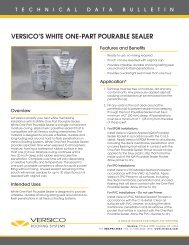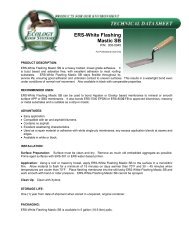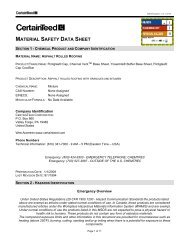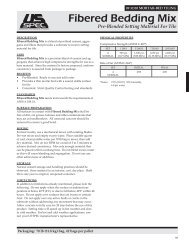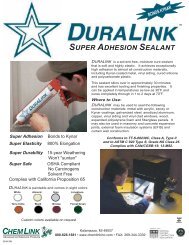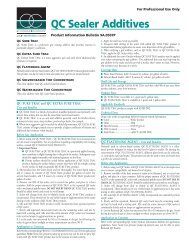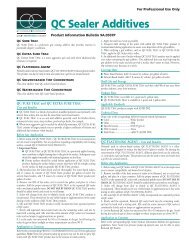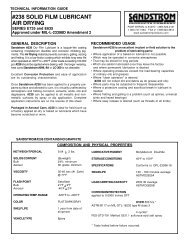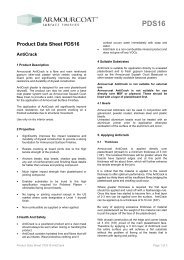Simpson Anchors - Anchoring and Fastening Systems - BuildSite.com
Simpson Anchors - Anchoring and Fastening Systems - BuildSite.com
Simpson Anchors - Anchoring and Fastening Systems - BuildSite.com
Create successful ePaper yourself
Turn your PDF publications into a flip-book with our unique Google optimized e-Paper software.
C-SAS-2009 © 2009 SIMPSON STRONG-TIE COMPANY INC.<br />
SUPPLEMENTAL TOPICS FOR ANCHORS<br />
ADHESIVE ANCHORS<br />
A1. Oversized Holes<br />
The performance data for adhesive anchors are based<br />
upon anchor tests in which holes were drilled with carbidetipped<br />
drill bits of the same diameter listed in the product’s<br />
load table. Additional static tension tests were conducted to<br />
qualify anchors installed with SET, ET, EDOT <strong>and</strong> Acrylic-Tie ®<br />
adhesives for installation in holes with diameters larger than<br />
those listed in the load tables. The tables indicate the acceptable<br />
range of drilled-hole sizes <strong>and</strong> the corresponding allowable<br />
tension-load reduction factor (if any). The same conclusions<br />
also apply to the published allowable shear load values. Drilled<br />
holes outside of the range shown below are not re<strong>com</strong>mended.<br />
Please note that the use of oversized holes is NOT permitted<br />
for anchors installed with SET-XP adhesive or the IXP Anchor<br />
with SET-XP adhesive.<br />
A2. Core-Drilled Holes<br />
The performance data for adhesive anchors are based upon anchor tests in<br />
which holes were drilled with carbide-tipped drill bits. Additional static tension<br />
tests were conducted to qualify anchors installed with SET, ET <strong>and</strong> Acrylic-Tie ®<br />
anchoring adhesives for installation in holes drilled with diamond-core bits.<br />
In these tests the diameter of the diamond-core bit matched the diameter of<br />
the carbide-tipped drill bit re<strong>com</strong>mended in the product’s load table. The test<br />
results showed that no reduction of the published allowable tension load for<br />
SET, ET <strong>and</strong> Acrylic-Tie anchoring adhesives is necessary for this condition.<br />
The same conclusions also apply to the published allowable shear loads.<br />
Please note that the use of core-drilled holes is NOT permitted for anchors<br />
installed with EDOT, SET-XP adhesive or the IXP Anchor with SET-XP <br />
adhesive.<br />
A3. Installation in Damp, Wet <strong>and</strong> Submerged Environments<br />
SET-XP : The performance data for adhesive anchors using SET-XP <br />
epoxy anchoring adhesive are based upon tests according to ICC-ES AC308.<br />
This criterion requires adhesive anchors that are to be installed in outdoor<br />
environments to be tested in water-saturated concrete holes that have been<br />
cleaned with less than the amount of hole cleaning re<strong>com</strong>mended by the<br />
manufacturer. A product’s sensitivity to this installation condition is considered<br />
in determining the product’s “Anchor Category” (strength reduction factor).<br />
Based on Reliability Testing per ICC-ES AC308<br />
• Dry Concrete – Cured concrete whose moisture content is in equilibrium<br />
with surrounding non-precipitate atmospheric conditions.<br />
• Water-Saturated Concrete – Cured concrete whose internal aggregate<br />
materials are soaked with moisture.<br />
• Submerged Concrete – Cured concrete that is covered with water <strong>and</strong><br />
water saturated.<br />
• Water-Filled Hole – Drilled hole in water-saturated concrete that is clean<br />
yet contains st<strong>and</strong>ing water at the time of installation.<br />
SET, ET, EDOT, Acrylic-Tie ® <strong>and</strong> VGC: The performance data for adhesive<br />
anchors using SET, ET, EDOT, Acrylic-Tie ® <strong>and</strong> VGC adhesives are based<br />
upon tests in which anchors are installed in dry holes. Additional static<br />
tension tests were conducted for some products in damp holes, water-fi lled<br />
holes <strong>and</strong> submerged holes. The test results show that no reduction of<br />
the published allowable tension load is necessary for SET, ET, EDOT , <strong>and</strong><br />
Acrylic-Tie ® adhesives in damp holes, or for SET <strong>and</strong> Acrylic-Tie adhesives in<br />
water-fi lled holes. For SET, ET, <strong>and</strong> Acrylic-Tie adhesives in submerged holes,<br />
the test results show that a reduction factor of 0.60 is applicable. The same<br />
conclusions also apply to the published allowable shear load values.<br />
Based on Service Condition Testing per ICC-ES AC58<br />
• Dry Concrete – Cured concrete whose moisture content is in equilibrium<br />
with surrounding non-precipitate atmospheric conditions.<br />
• Damp Hole - A damp hole, as defi ned in ASTM E1512 <strong>and</strong> referenced<br />
in ICC-ES AC58, is a drilled hole that has been properly drilled, cleaned<br />
<strong>and</strong> then is fi lled with st<strong>and</strong>ing water for seven days. After seven days,<br />
the st<strong>and</strong>ing water is blown out of the hole with <strong>com</strong>pressed air <strong>and</strong> the<br />
adhesive anchor is installed.<br />
Epoxy-Tie ® (SET <strong>and</strong> ET)<br />
Insert<br />
Diameter<br />
(in.)<br />
Acceptable Hole<br />
Diameter Range<br />
(in.)<br />
Acceptable Load<br />
Reduction Factor<br />
³⁄₈ ¹⁄₂ - ³⁄₄ 1.0<br />
¹⁄₂ ⁵⁄₈ - ¹⁵⁄₁₆ 1.0<br />
⁵⁄₈ ³⁄₄ - 1¹⁄₈ 1.0<br />
³⁄₄ ⁷⁄₈ - 1⁵⁄₁₆ 1.0<br />
⁷⁄₈ 1 - 1¹⁄₂ 1.0<br />
1 1¹⁄₈ - 1¹¹⁄₁₆ 1.0<br />
1¹⁄₈ 1¹⁄₄ - 1⁷⁄₈ 1.0<br />
1¹⁄₄ 1³⁄₈ - 2¹⁄₁₆ 1.0<br />
1³⁄₈ 1¹⁄₂ - 2¹⁄₄ 1.0<br />
• Water-Filled Hole - A water-fi lled hole is defi ned similarly to a damp<br />
hole; however, the st<strong>and</strong>ing water is not blown out of the hole. Instead,<br />
the adhesive is injected directly into the water-fi lled hole (from the<br />
bottom of the hole up) <strong>and</strong> the insert is installed.<br />
• Submerged Hole - A submerged hole is similar to a water-fi lled hole with<br />
one major exception – in addition to st<strong>and</strong>ing water within the hole; water<br />
also <strong>com</strong>pletely covers the surface of the base material as well. Note<br />
that drilling debris <strong>and</strong> sludge should be removed from the drilled hole<br />
prior to installation. ASTM E1512 <strong>and</strong> ICC-ES AC58 do not address this<br />
condition.<br />
A4. Elevated In-Service Temperature<br />
The performance of all adhesive anchors is affected by elevated base<br />
material temperature. The in-service temperature sensitivity table provided<br />
for each adhesive provides the information necessary to apply the appropriate<br />
load-adjustment factor to either the allowable tension based on bond strength<br />
or allowable shear based on concrete edge distance based for a given base<br />
material temperature. While there is no <strong>com</strong>monly used method to determine<br />
the exact load-adjustment factor, there are a few guidelines to keep in mind<br />
when designing an anchor that will be subject to elevated base-material<br />
temperature. In any case, the fi nal decision must be made by a qualifi ed<br />
design professional using sound engineering judgment:<br />
• When designing an anchor connection to resist wind <strong>and</strong>/or seismic<br />
forces only, the effect of fi re (elevated temperature) may be disregarded.<br />
• The base-material temperature represents the average internal<br />
temperature <strong>and</strong> hence, the temperature along the entire bonded length<br />
of the anchor.<br />
• The effects of elevated temperature may be temporary. If the in-service<br />
temperature of the base material is elevated such that a load-adjustment<br />
factor is applicable, but over time the temperature is reduced to a<br />
temperature below which a load-adjustment factor is applicable, the<br />
full allowable load based on bond strength is still applicable. This is<br />
applicable provided that the degradation temperature of the anchoring<br />
adhesive (350º F for SET-XP , SET, ET, <strong>and</strong> AT) has not been reached.<br />
A5. Creep Under Long-Term Loads<br />
Acrylic-Tie ®<br />
Insert<br />
Diameter<br />
(in.)<br />
Acceptable<br />
Hole Diameter<br />
Range<br />
(in.)<br />
Acceptable<br />
Load<br />
Reduction<br />
Factor<br />
³⁄₈ ⁷⁄₁₆ - ¹⁄₂ 1.0<br />
¹⁄₂ ⁹⁄₁₆ - ⁵⁄₈ 1.0<br />
⁵⁄₈ ¹¹⁄₁₆ - ³⁄₄ 1.0<br />
³⁄₄ ¹³⁄₁₆ - ⁷⁄₈ 1.0<br />
⁷⁄₈ 1 1.0<br />
1 1¹⁄₁₆ - 1¹⁄₈ .75 for 1¹⁄₈ only<br />
1. Anchor diameters over 1" in diameter were not<br />
tested for greater than ¹⁄₁₆" hole overdrill.<br />
Creep is the slow continuous deformation of a material under constant<br />
stress. Creep occurs in many construction materials, including concrete <strong>and</strong><br />
steel when the stress is great enough. The creep characteristics of adhesives<br />
are product dependent. Adhesive anchors that are not creep resistant can pull<br />
out slowly over time when sustained tensile loads are applied.<br />
Because of the creep phenomenon, it is important for Designers to consider<br />
the nature of the applied tension loads <strong>and</strong> to determine if the tension loads<br />
will be continuously applied to the anchor over the long-term. If this is the<br />
case, a product that is suitable for resisting sustained loads over the long-term<br />
must be selected.<br />
All <strong>Simpson</strong> Strong-Tie anchoring adhesives (SET-XP , SET, ET, EDOT,<br />
Acrylic-Tie ® <strong>and</strong> VGC) have been qualifi ed for resisting long-term loads<br />
through ICC-ES AC58 or AC308 “creep tests” in which an anchor is loaded <strong>and</strong><br />
monitored for movement over time. According to AC58 <strong>and</strong> AC308, anchors<br />
that pass the creep test are determined to be suitable for resisting long-term<br />
tensile loads.<br />
15



